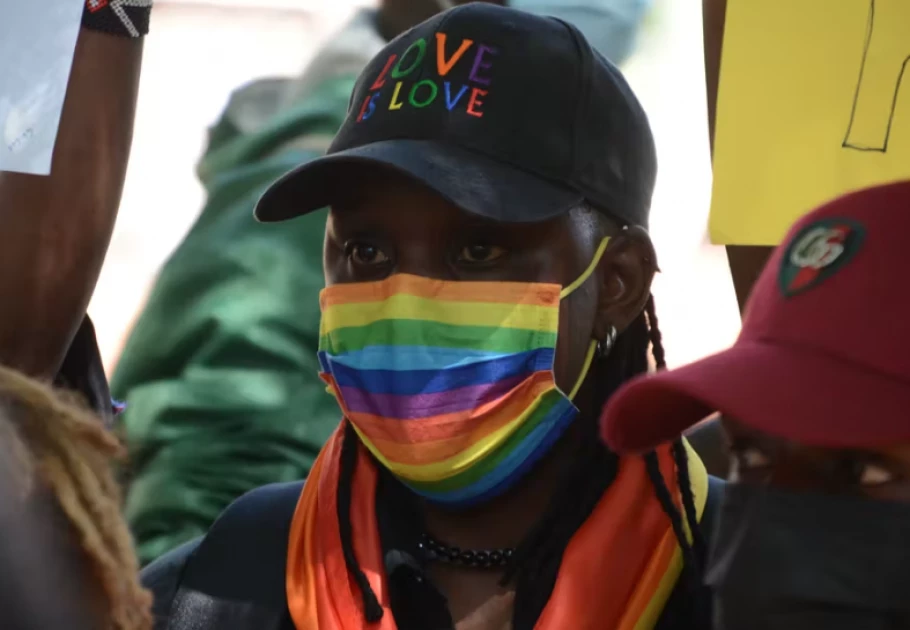#JusticeForSheila highlights the precarious lives of queer people in Kenya

A Nairobi protest against homophobic statements made by a government minister. JOHN OCHIENG/SOPA Images/LightRocket
Kenya
is one of 32
countries in Africa that criminalise homosexuality. People who
identify as lesbian, gay, bisexual, transgender and intersex (LGBTI) are
frequently stigmatised, shamed and assaulted. The hashtags calling for action
against the murder of queer people – like the most recent #JusticeForSheila –
continue to trend on social media. We asked gender studies professor Awino
Okech to tell us about the state of homophobic violence against queer Kenyans –
and what needs to be done about it.
Who
is Sheila Lumumba and what is #JusticeForSheila?
Sheila Lumumba was a 25-year-old
non-binary lesbian (they did not identify as either a woman or a man) who was
found dead in Karatina, north of Nairobi, on 17 April 2022. Lumumba was
reportedly raped and murdered in the most gruesome manner. #JusticeForSheila is a hashtag that
mobilises public engagement on the murder of queer people in Kenya generally
and calls for public accountability for Sheila’s murder.
This
hashtag is part of a history of social media organising in
Kenya around the death of women, sex workers and queer people such as #JusticeforSharon, #JusticeforJoash and #Justiceforericachandra. Social media and
Twitter in particular have become an important space for pursuing societal
accountability in an environment where some lives are deemed disposable and
receive limited attention in the justice system.
How
prevalent are such attacks in Kenya?
In
a hostile environment for queer people, documentation from civil society
organisations only captures part of the story. The Gay and Lesbian Coalition of
Kenya reports that “in Kenya, 53% of LGBTQ+
people are physically assaulted – that’s every second person.” Anecdotal
evidence from media reports points to a pattern of attacks that range from
murder and sexual assault to other forms of physical attacks and threats. In
2021, at least three reports were captured in mainstream media that involved
either murder or suspicious deaths.
Last year a transgender woman was murdered, and their body dumped on the
streets in Nairobi. In the same year, a Ugandan refugee died from burn injuries associated with an
attack on a group of queer refugees at Kakuma refugee camp and a peer educator with a queer organisation in Mombasa was found dead in
his apartment. In 2020, a queer activist was found dead in her apartment under what
were deemed suspicious circumstances.
Another
key feature of homophobia against queer people in Kenya involves the
persistent threat of homelessness if their sexual orientation is “discovered”
by family or owners of rental property. It is important, that in reading about
queer death and violence we recognise the class disaparities that shape how
people experience homophobia and transphobia.
Do
Kenya’s anti-LGBTI laws enable the attacks?
What
are described as “anti-homophobic laws” are in fact relics from the colonial
era in the Kenyan penal code. Indeed, the 2019 Repeal162 case in Kenya was a direct
effort by queer organisations to challenge these provisions in the penal
code. Section 162 and 165 of the Kenyan penal code criminalise what is referred
to as “carnal knowledge against the order of nature”, which is often assumed to
target same sex partners. The penalties range from 14 to 5 years imprisonment
respectively.
These
laws have since independence been used by the government to define African-ness
and African culture in heterosexual and patriarchal terms thus justifying and
cushioning violence.
What
social forces drive the attacks?
The
basis for attacks springs from two things. The first are ideas about how gender
is governed in society. This is anchored in patriarchy, a system that
distributes power between women and men, girls and boys unequally by
privileging men and prescribing accompanying roles, behaviour and expected
norms.
The
second is the assumption that heterosexuality is the only way we can understand
or experience sexuality. People who deviate from these societal prescriptions
become targets of violence.
To
understand transphobia and homophobia, we must return to how societies think
about (or refuse to think about) gender and sexuality and the structures of
power that benefit from this refusal. The logic that informs homophobia and
transphobia is the same one that underpins femicide and violence against
women.
For
example, the murder of Sharon Otieno, a young university student,
animated conversations about death and violence as justifiable actions against
young women who go against the norm by engaging in sexual relationships with
older men. The same logic was present in the 2013 case of Rachel Shebesh, a member of parliament, who was
slapped in public by the then Nairobi governor for daring to pursue the rights
of unpaid city council workers.
What
can be done about the problem?
There
are three possible ways to answer this. First, if you believe in the justice
system as an effective mechanism to address injustice in societies, then
strengthening the response of the legal and policing system to these attacks
and deaths is one way to deal with the problem.
Two,
for those who see legal and policing systems as fundamentally flawed because
they punish rather than restore relations, the answer is to build movements
that keep targeted communities safe.
Third,
the long term, often difficult work of conscientising communities remains an
important route to societal transformation and informs action one and two above.
[Awino
Okech is an Associate professor in
political sociology, SOAS, University of London]
Want to send us a story? SMS to 25170 or WhatsApp 0743570000 or Submit on Citizen Digital or email wananchi@royalmedia.co.ke
Comments
No comments yet.


Leave a Comment